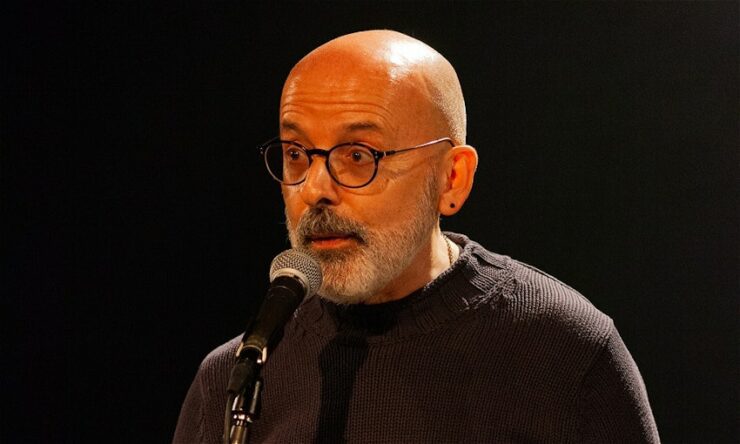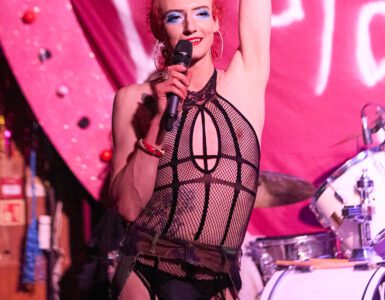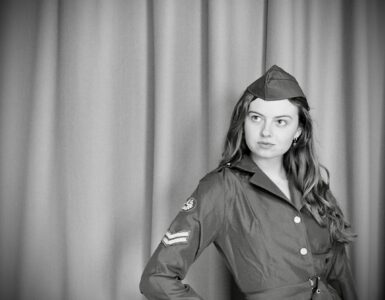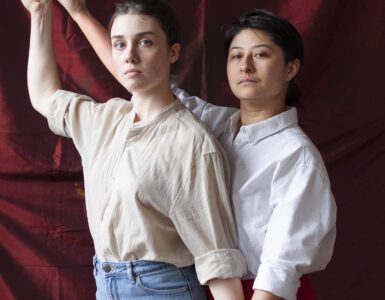A two-part monologue-style play about a queer childhood and revelatory adulthood is what’s on offer from Prague Fringe stalwart John Arthur Sweet. Taking an excitingly episodic approach to his performance, he details his upbringing in a small town in Canada, diving deep into his past to tell a story of discovery, role models and artistry. We sat down with J.A.S for a pixelated pilsner to get behind the curtain of Outside, in the Laneway, under the Stars.
Catch Part 1 of Outside, in the Laneway, under the Stars on the 24th and 26th of May, and Part 2 on the 25th and 27th May (times vary by date). Tickets for Part 1 are available from the Prague Fringe Box Office. As are Tickets for Part 2.
Jake: Hi J.A.S! Your show handles tackles your upbringing in a small town in Canada, where queerness wasn’t a “thing” – how has it felt bringing that story to the stage?
J.A.S: As I write this, I’m in Brighton, at the Brighton Fringe, where I’ve now performed Part 1 of my show twice, and Part 2 once. Performing the show, I am finding that it’s a deep dive into my past, and the not-so-great part of it (bullying) that really coloured everything that came after. I can say that I effectively buried (at some cost) my story of bullying for a good twenty or thirty years. Revisiting it is tough, but also curiously comforting. I feel like a queer survivor.
Jake: Tell us a little bit about your process of turning an autobiographical queer discovery story to the stage – what’s your process?
J.A.S: This show has been gestating for a loooooooooong time. It all began with me discussing with a friend (straight) how I had no gay or queer role models growing up. I went to high school between 1975 and 1980, and there were no openly gay teachers or students, and I really didn’t know what “gay” was. So I tried to write about what I understood at that time about this subject (homosexuality) that was so shrouded in mystery. That was at least eight or nine years ago! And then I wrote other pieces, some of which are stand-alone stories that I performed at spoken word evenings and such. And finally, during the pandemic, I looked at these various texts I’d written and I decided I had an autobiographical show of some length. I wrote some new bits to kind of tie it all together, and the result is outside, in the laneway, under the stars.
Jake: The show takes place over two parts – tell us a little about the reasons for that and what we can expect from each part.
J.A.S: It’s in two parts only because it’s so long, and I think it’s unreasonable to ask people to sit for two hours. The thing I really want to say about it is that YOU DON’T NEED TO SEE BOTH PARTS. I perform also as a spoken word artist, doing short performances of five to twenty minutes in the context of spoken word soirées or cabarets, so you could think of the show as two spoken word evenings around one theme. So it’s like a symphony: you can listen to the whole thing, or just one movement.
Jake: You say the show partly covers the “limitations of seeking solace in art”, what are those limitations and what has it meant for your life and the piece?
J.A.S: Oh wow, what a question. To be brief, I’d say that at some point one needs to live in the real world. I am by nature an imaginative person, and during my later childhood and adolescence I turned more and more to living in my imagination. I was a voracious reader, and was always happy to spend hours by myself, reading or acting out little dramas for myself! This was a reaction to relentless bullying at school, and this rich inner life is what saved me. But life is ultimately about relationships with other people, with nature, with the physical world. It was a long, long time before I was comfortable just being myself in relation to others. It’s still a struggle. This show is my way of being in communication with others. But at some point, you know, it’s nice to hug someone! And that doesn’t happen in one’s imagination. It needs to be for real, a physical act.
I could go on for a long time about this, but really, it’s the subject of my show, so if you see the show, you’ll understand what I think about this. Art is great, but we don’t live in art galleries or in theatres or (shudder) on the other side of a mobile phone’s screen. We’re physical beings, and we need to embrace that—and each other.
Jake :Now that we’re gearing up for Prague Fringe, what are you most excited for?
J.A.S: This will be my fifth visit to the Prague Fringe (I did shows previously in 2009, 2014, 2015 and 2019). I just love the atmosphere of the Prague Fringe. Of course, the city is gorgeous (it gets my vote for the most beautiful city in the world). But the Fringe itself is so special, so supportive and collegial. The Prague Fringe is my happy place. So I’m just delighted to have been invited again. I look forward to meeting up with old friends and with people who have seen some of my previous shows. I look forward to seeing lots of shows. I look forward to bumping into people in the street and having conversations with them. I look forward to having a G&T at the Fringe Club!
Jake: Given the themes of Binge Fringe, if your show was a beverage of any kind (alcoholic, non-alcoholic – be as creative as you like!), what would it be and why?
J.A.S: I will admit, I’m enjoying a gin and tonic right now, as I write this. And I think I could do worse than compare my show to a G&T. It’s sweet on the surface (Sweet, even, given my name) but with a slightly bitter undertaste. It’s sophisticated and multilayered, but ultimately clear. At heart, I’m a working-class kid, so this would be a G&T made with a popular and inexpensive gin, not this artisan stuff that is so popular today. Gordon’s, maybe? And the tonic would be Canada Dry! (Look it up.)
Hear the latest from Marginalised Voices from Fringes across the World
Subscribe to our Email Newsletter so we can send you insightful updates about unheard creative voices working to platform powerful stories. You'll be the first to hear about our content and how to apply to have shows you're working on reviewed.
Powered by EmailOctopus









